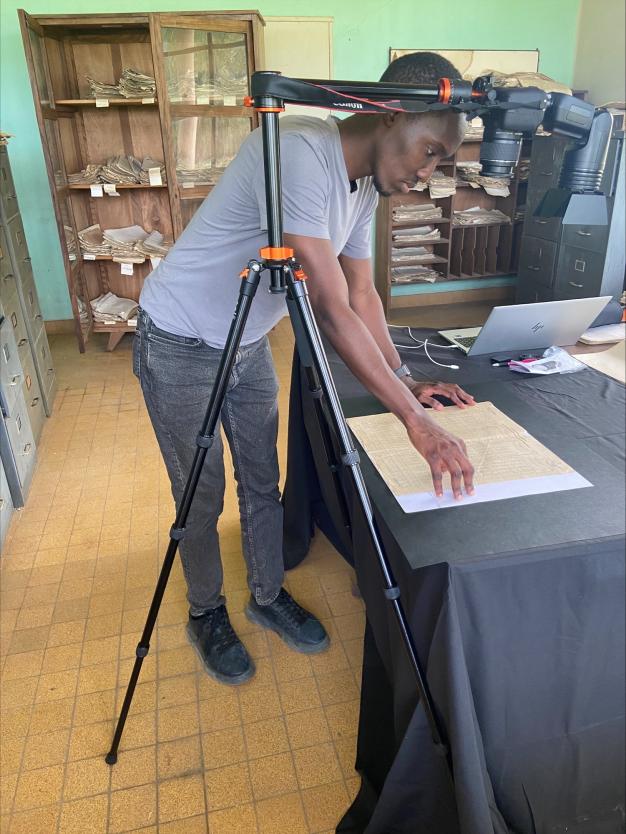In the summer of 2023 VUB climate researcher Derrick Muheki rode a motorbike deep into the Congo Basin to scan old weather logs. Back in Brussels, he developed MeteoSaver, a tool that converts the handwritten records into digital text. His journey caught the attention of Nature, and now TIME has recognised MeteoSaver as one of the Best Inventions of 2025 (special mention). “It took me a few days to believe it was real,” says the young scientist.
The archive of INERA – the National Institute for Agronomic Studies in the Democratic Republic of Congo – contains meteorological logs from 37 weather stations, collected since independence in 1960. The archive is based in Yangambi, which is difficult to reach. In 2023, Derrick flew from Kinshasa to Kisangani, travelled part of the way down the Congo River by boat, and then continued by motorbike on a dirt road.”
Derrick Muheki: “The motorbike is the main mode of public transport there. I sat on the back while my equipment – a camera, lamps and a generous supply of batteries – travelled on a second bike. There’s no electricity grid in the area, not even in the archive itself. The only power comes from batteries and generators.”
Derrick Muheki at work in Yangambi
What condition was the archive in?
“In Belgium colonial-era meteorological logs are stored in metal boxes and acid-free paper under controlled temperature and humidity. In Yangambi, those resources simply aren’t available. Documents were stacked on open shelves, exposed to moisture and insects. Just a few months before I arrived, there had even been a fire in another wing of the building. Seeing that really drives home how fragile paper archives are—and how urgent it is to save this data before it disappears.”
What did you do during your stay?
“I spent two months scanning documents—about 9,000 in total.”
That sounds like a huge task...
“It went surprisingly well. The collaboration with INERA staff was great, my work wouldn’t have been possible without the help of this local partner. They diligently collected the observations and preserved them for decades. I’m originally from south-west Uganda, near the Congolese border. To my surprise, Lingala—the local language—turned out to be quite similar to my own, Runyankole. I picked up some key words and phrases quickly, which helped me get by just fine.”
Back in Brussels, you faced a second challenge: transcribing the handwriting.
“Normally, transcription is done manually, often through citizen science projects where volunteers or students decipher and retype all the numbers and notes. It’s slow, painstaking work. We wanted to automate it, so I developed a machine-learning tool: MeteoSaver. I was able to rely on support from colleagues at Ghent University, who have been working in Yangambi for decades and also shared their expertise in text mining.”
"We eventually reached over 90% accuracy, which is on par with human transcription”
What were the main obstacles?
“First, the documents came in all kinds of formats and paper qualities. Then there were the tables—transcription tools usually struggle with those. And of course, the handwriting. I’d never realised how much variation there can be: some people’s 3 looks like an 8, others blur the difference between 2 and 9. I tested all the existing tools, but none worked well—they’re designed for printed text.”
And MeteoSaver performs better?
“Not right away. At first, it achieved about 75% accuracy. But using Tesseract—an open-source optical recognition engine—combined with machine learning, we gradually improved the results. We eventually reached over 90% accuracy, which is on par with human transcription.”
What’s next for MeteoSaver?
“The tool comes with a manual and is fully open-source, so anyone can download and use it for free. The ‘data rescue’ community—people working to save and unlock old scientific archives—has been really enthusiastic. Researchers in Belgium, the Netherlands and the UK are already testing it. We hope many others will follow. The climate science community stands to benefit enormously.”
Derrick Muheki is currently working on a PhD about hydroclimatological trends in the Congo Basin. Prof. Wim Thiery, Muheki’s PhD supervisor and head of the bclimate research group at VUB, calls MeteoSaver a game-changer for climate research.
Wim Thiery: “Climate models are only as good as the data we feed into them. For central Africa and other parts of the Global South, much of that data is missing—often just sitting on shelves or in basements. That gap contributed to the lack of African data in the 2021 IPCC report assessing the pace and severity of global warming. Tools like MeteoSaver help close that gap and make our models more robust.”
How can the Democratic Republic of Congo itself benefit?
“The data can help scientists study the effects of climate change on extreme weather events—for example, whether droughts and floods occurred differently in the past than they do today.”
Could the tool also be useful elsewhere?
Wim Thiery: “Absolutely. Even in the Global North, many archives remain undigitised. Some contain data from former colonies—for instance, Dutch archives include records from the Caribbean, while the UK has hundreds of thousands of documents from its time as a global empire. By digitising and sharing that data, we’re effectively returning it to the countries it came from.”

How far back can you go with this kind of data?
“Further than 1850. That year is often used as the dividing line between the pre-industrial and industrial eras—the start of human impact on the climate—but mainly because measurements before that were deemed unreliable. In reality, valuable meteorological data from as early as the late 1700s still exists in archives.”
Are there still discoveries to be made in Belgium’s own archives?
“Definitely. The Royal Meteorological Institute of Belgium (RMI) has the world’s longest continuous record of air pressure measurements—daily readings since 1833, all taken in Brussels using consistent scientific methods. Those records are hugely valuable for international climate research. They can, for instance, reveal when the most intense storms of the past two centuries occurred—and how they compare to today’s. Even these data still need to be digitised.”

About the researcher
Derrick Muheki earned a joint Master’s degree in Water Resources Engineering (VUB–KU Leuven) and currently holds an FWO PhD Fellowship funded by the Research Foundation–Flanders, allowing him to conduct his doctoral research independently.
About the researcher
Prof. Wim Thiery was appointed Research Professor at VUB in 2017 and leads the bclimate group. He co-authored the IPCC Special Report on Climate Change and Land (2019) and the Sixth Assessment Report (2021). His expertise spans climate change, extreme weather, regional and global climate modelling, land–atmosphere interactions, storm early-warning systems, energy meteorology and large-scale climate impact modelling.
